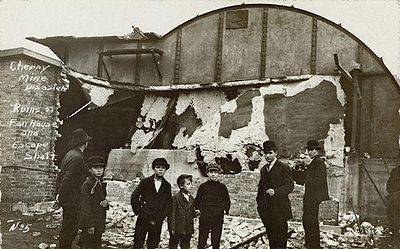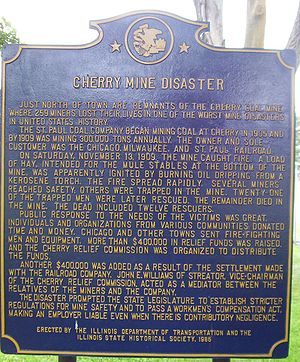
Cherry Mine Disaster
Encyclopedia

Cherry, Illinois
Cherry is a village in Bureau County, Illinois, United States. The population was 509 at the 2000 census. It is part of the Ottawa–Streator Micropolitan Statistical Area...
, USA coal mine in 1909 in which 259 men and boys died.
Background
The Cherry Mine had been opened in 1905 by the Chicago, Milwaukee, and St. Paul RailroadChicago, Milwaukee, St. Paul and Pacific Railroad
The Milwaukee Road, officially the Chicago, Milwaukee, St. Paul and Pacific Railroad , was a Class I railroad that operated in the Midwest and Northwest of the United States from 1847 until its merger into the Soo Line Railroad on January 1, 1986. The company went through several official names...
to supply coal for their trains. The mine consisted of three horizontal veins, each deeper than the last. The veins were connected vertically by two shafts set some 100 yards apart. Both the main shaft and the secondary shaft contained wooden stairs and ladders. The main shaft was capped by an 85-foot steel tower which controlled a mechanical hoisting cage. A large fan, located in a shunt off the secondary shaft, pushed fresh air into the mine.
The miners included a large number of immigrants, heavily Italian, many of whom could not speak English. Boys as young as 11 years old also worked the mine. Rather than a fixed per-hour wage, pay was based on the coal production.
The disaster
On Saturday, November 13, 1909, like most days, nearly 500 men and boys, and three dozen mules, were working in the mine. Unlike most days, an electrical outage earlier that week had forced the workers to light keroseneKerosene
Kerosene, sometimes spelled kerosine in scientific and industrial usage, also known as paraffin or paraffin oil in the United Kingdom, Hong Kong, Ireland and South Africa, is a combustible hydrocarbon liquid. The name is derived from Greek keros...
lanterns and torches, some portable, some set into the mine walls.
Shortly after noon, a coal car filled with hay for the mules caught fire from one of the wall lanterns. Initially unnoticed and, by some accounts, ignored by the workers, efforts to move the fire only spread the blaze to the timbers supporting the mine.
The large fan was reversed in an attempt to blow out the fire, but this only succeeded in igniting the fan house itself as well as the escape ladders and stairs in the secondary shaft, trapping more miners below.
The two shafts were then closed off to smother the fire, but this also had the effect of cutting off oxygen to the miners, and allowing the “black damp,” a suffocating mixture of carbon dioxide and nitrogen, to build up in the mine.
Some 200 men and boys made their way to the surface, some through escape shafts, some using the hoisting cage. Some miners who had already escaped returned to the mine to aid their coworkers. Twelve of these, led by John Bundy, made six dangerous cage trips, rescuing many others. The seventh trip, however, proved fatal when the cage operator misunderstood the miners' signals and brought them to the surface too late - the rescuers and those they attempted to rescue were burned to death.
One group of miners trapped in the mine built a makeshift wall to protect themselves from the fire and poisonous gases. Although without food, they were able to drink from a pool of water leaking from a coal seam, moving deeper into the mine to escape the black damp. Eight days later, the 21 survivors, known as the "eight day men", tore down the wall and made their way through the mine in search of more water, but came across a rescue party instead. One of those 21 survivors died two days later with complications from asthma.
Aftermath

A monument to those who lost their lives was erected May 15, 1971 by the Illinois Department of Transportation
Illinois Department of Transportation
The Illinois Department of Transportation is a state agency in charge of state-maintained public roadways of the U.S. state of Illinois. In addition, IDOT provides funding for rail, public transit and airport projects and administers fuel tax and federal funding to local juridictions in the...
and the Illinois State Historical Society.
The centennial commemoration of the Cherry Mine Disaster was held in Cherry, November 14–15, 2009. A new monument, located at the Cherry Village Hall, was dedicated to the miners who lost their lives in the disaster.

